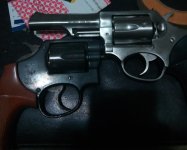There are always pros and cons and what makes sense for your wife will depend on what's important for your wife.
Below are some of the J and J Magnum frame S&W options.
Top to bottom, a 3" Model 60 and a 2.125" Model 60 (both J Magnum frames in .357 Mag), a J Magnum frame Model 36 rated for .38 +P, and a J frame Model 36 designed for .38 Special.
In my experience, the 3" barrel is just as easy to carry and conceal as a 2.125" barrel, so if you have a choice between the two always take the 3". You'll get more ballistic efficiency regardless of whether you shoot .357 Magnum, .38 +P or .38 Special, and if you shoot .38 Special you really need the longer barrel to get acceptable terminal performance.
Three of the above revolvers have a Hogue Monogrip and they are comfortable, reduce felt recoil and make the revolver a bit easier to hold and control. It's less of an issue with .38 Special, but more comfort does increase the potential the person will actually shoot the revolver enough to get good with it. The wooden boot grips is small and compact, but it less comfortable to shoot.
Below are the above mentioned 3" and 2.125" Model 60 (bottom two on the right), with some of the alternatives.
Top right is a 3" SP101. In comparison to the 3" Model 60, there are some pros and cons. The SP101 is about 5 oz heavier than the Model 60. That's enough additional weight to make it much less painful to shoot with .357 Magnum and noticeably more comfortable to shoot with .38 +P or .38 Special. It also isn't enough extra weight to make it noticeably less comfortable to carry.
The SP101 is built substantially stronger than the J Magnum Model 60. Particularly around the forcing cone:
The only con is that the SP 101's stock trigger tends to be heavier than the average Model 60 standards, but that's fairly easy to fix by replacing the trigger return spring and the hammer spring.
The Ruger trigger feels a bit more mechanical, but that's either a pro or a con depending the shooter's preference.
Going back to the middle picture, you can also go in frame size. On the top left is a K frame 3" Model 19. It's about 5 oz heavier than an SP101, but it is noticeably larger. Middle left is a 2 3/4" Ruger Speed Six. It a couple ounces heavier than the Model 19, at about 37 oz loaded, and it's generally comparable to the S&W L frame (and the K and L frames share the same grip frame. Bottom left is a K frame 2 1/2 Model 66. All of the above are chambered for .357 Magnum, but shoot .38 +P or .38 Special just fine. If your wife plans to actually carry .357 Magnum, then I recommend she get a K or L frame revolver, or a Ruger GP100.
One advantage of the GP100, like the SP101 is that the peg grip frame allows for a much broader range of grip sizes and trigger reaches than the S&W revolvers. That's a major advantage if the shooter has smaller hands.
A 2 1/2" or 3" K or L frame revolver is generally not hard to conceal - for an average man carrying it IWB. However, it can be a bit much for some women. Off body carry is an option, but it's an option with a lot of downsides that warrants it's own thread.
-----
At the end of the day, all of the above work, but it really comes down to getting your wife something that she's comfortable with, points well for her, and that she'll actually shoot and practice with.
Way too many people regard a snub nose revolver as something to just point in the general direction of an assailant and pull the trigger, along with a belief that they are not accurate. That's not the case at all. They are capable of fine combat accuracy (although recovery time and rate of fire improve on the larger frame snub nose revolvers). If someone is carrying .38 Special, good bullet placement is important, as the round itself is a bit marginal.









